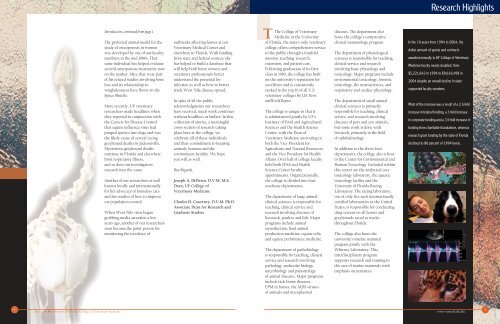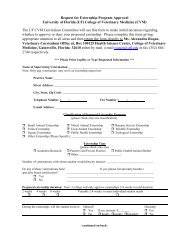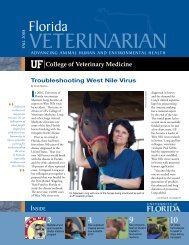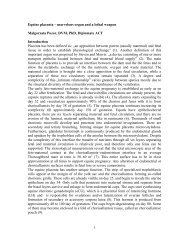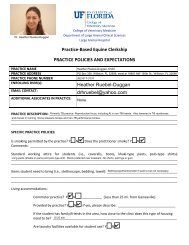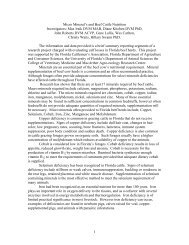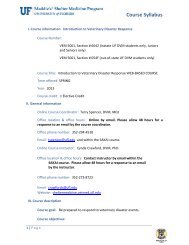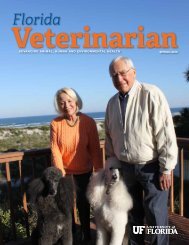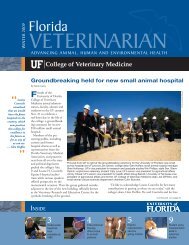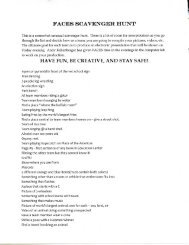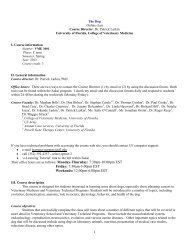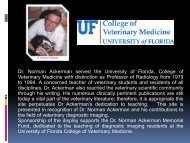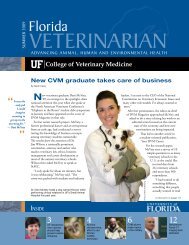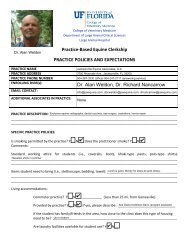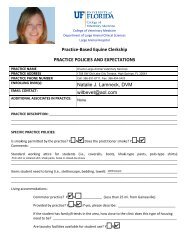College of Veterinary Medicine Research Brochure
College of Veterinary Medicine Research Brochure
College of Veterinary Medicine Research Brochure
- No tags were found...
You also want an ePaper? Increase the reach of your titles
YUMPU automatically turns print PDFs into web optimized ePapers that Google loves.
<strong>Research</strong> HighlightsIntroduction, continued from page 1The preferred animal model for thestudy <strong>of</strong> osteoporosis in womenwas developed by one <strong>of</strong> our facultymembers in the mid 1980s. Thatsame individual has helped evaluateseveral osteoporosis treatments nowon the market. Mice that were part<strong>of</strong> his related studies involving boneloss and its relationship toweightlessness have flown on theSpace Shuttle.More recently, UF veterinaryresearchers made headlines whenthey reported in conjunction withthe Centers for Disease Controlthat equine influenza virus hadjumped species into dogs and wasthe likely cause <strong>of</strong> several racinggreyhound deaths in Jacksonville.Mysterious greyhound deathscontinue in Florida and elsewherefrom respiratory illness,and so does our investigators’research into the cause.Another <strong>of</strong> our researchers is wellknown locally and internationallyfor her advocacy <strong>of</strong> homeless catsand her studies <strong>of</strong> how to improvecat population control.When West Nile virus begangrabbing media attention a fewyears ago, another <strong>of</strong> our researcherssoon became the point person formonitoring the incidence <strong>of</strong>outbreaks affecting horses at our<strong>Veterinary</strong> Medical Center andelsewhere in Florida. With fundingfrom state and federal sources, shehas helped to build a database thatwill help both horse owners andveterinary pr<strong>of</strong>essionals betterunderstand the potential forinfection as well as how to bettertrack West Nile disease spread.In spite <strong>of</strong> all the publicacknowledgments our researchershave received, much work continueswithout headlines or fanfare. In thiscollection <strong>of</strong> stories, a meaningfulcross-section <strong>of</strong> research takingplace here at the college, wecelebrate all <strong>of</strong> these individualsand their commitment to keepinganimals, humans and theenvironment healthy. We hopeyou will as well.Best Regards,Joseph A. DiPietro, D.V.M. M.S.Dean, UF <strong>College</strong> <strong>of</strong><strong>Veterinary</strong> <strong>Medicine</strong>Charles H. Courtney, D.V.M. Ph.D.Associate Dean for <strong>Research</strong> andGraduate StudiesTThe <strong>College</strong> <strong>of</strong> <strong>Veterinary</strong><strong>Medicine</strong> at the University<strong>of</strong> Florida, the state’s only veterinarycollege, <strong>of</strong>fers comprehensive serviceto the public through a fourfoldmission: teaching, research,extension, and patient care.Following graduation <strong>of</strong> its firstclass in 1980, the college has builton the university’s reputation forexcellence and is consistentlyranked in the top 10 <strong>of</strong> all U.S.veterinary colleges by U.S. Newsand World Report.The college is unique in that itis administered jointly by UF’sInstitute <strong>of</strong> Food and AgriculturalSciences and the Health ScienceCenter, with the Dean <strong>of</strong><strong>Veterinary</strong> <strong>Medicine</strong> answering toboth the Vice President forAgriculture and Natural Resourcesand the Vice President for HealthAffairs. Over half <strong>of</strong> college facultyhold both IFAS and HealthScience Center facultyappointments. Organizationally,the college is divided into fouracademic departments.The department <strong>of</strong> large animalclinical sciences is responsible forteaching, clinical service andresearch involving diseases <strong>of</strong>livestock, poultry and fish. Majorprograms include animalreproduction, food animalproduction medicine, equine colicand equine performance medicine.The department <strong>of</strong> pathobiologyis responsible for teaching, clinicalservice and research involvingpathology, molecular biology,microbiology and parasitology<strong>of</strong> animal diseases. Major programsinclude tick-borne diseases,EPM in horses, the AIDS viruses<strong>of</strong> animals and mycoplasmaldiseases. The department alsohosts the college’s comparativeclinical immunology program.The department <strong>of</strong> physiologicalsciences is responsible for teaching,clinical service and researchinvolving basic physiology andtoxicology. Major programs includeenvironmental toxicology, forensictoxicology, the neurosciences, andrespiratory and cardiac physiology.The department <strong>of</strong> small animalclinical sciences is primarilyresponsible for teaching, clinicalservice, and research involvingdiseases <strong>of</strong> pets and zoo animals,but some work is done withlivestock, primarily in the field<strong>of</strong> ophthalmology.In addition to the above fourdepartments, the college also is hostto the Center for Environmental andHuman Toxicology. Included withinthis center are the analytical coretoxicology laboratory, the aquatictoxicology facility and theUniversity <strong>of</strong> Florida RacingLaboratory. The racing laboratory,one <strong>of</strong> only five such internationallycertified laboratories in the UnitedStates, is responsible for conductingdrug screens on all horses andgreyhounds raced at tracksthroughout Florida.The college also hosts theuniversity’s marine mammalprogram jointly with theWhitney Laboratory. Thisinterdisciplinary programsupports research and training inthe care <strong>of</strong> marine mammals withemphasis on manatees.In the 10 years from 1994 to 2004, thedollar amount <strong>of</strong> grants and contractsawarded annually to UF <strong>College</strong> <strong>of</strong> <strong>Veterinary</strong><strong>Medicine</strong> faculty nearly doubled, from$5,221,642 in 1994 to $9,616,498 in2004 despite an overall decline in statesupportedfaculty numbers.Most <strong>of</strong> the increase was a result <strong>of</strong> a 2.5-foldincrease in federal funding, a 3-fold increasein corporate funding and a 3.5-fold increase infunding from charitable foundations, whereasresearch grant funding by the state <strong>of</strong> Floridadeclined to 80 percent <strong>of</strong> 1994 levels.4<strong>Research</strong> • University <strong>of</strong> Florida <strong>College</strong> <strong>of</strong> <strong>Veterinary</strong> <strong>Medicine</strong>••www.vetmed.ufl.edu5


